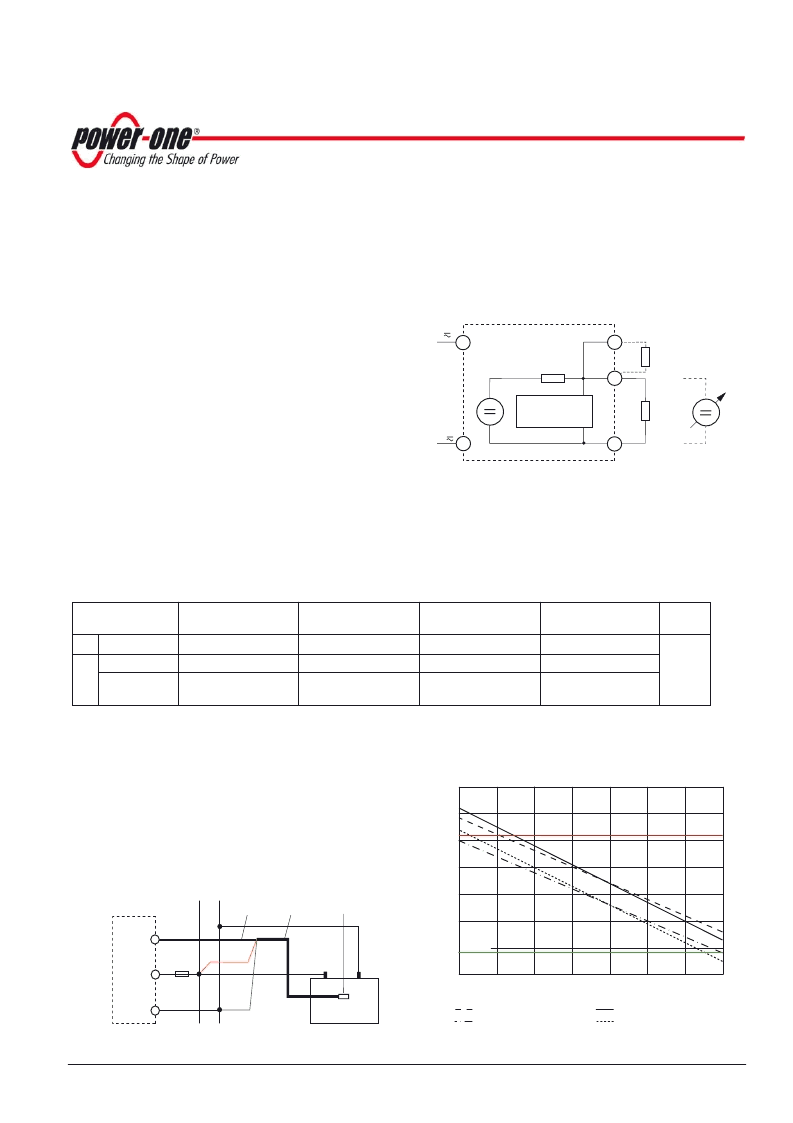- 您現(xiàn)在的位置:買(mǎi)賣IC網(wǎng) > PDF目錄367582 > LOS4601-2RLD DIN-Rail Mountable AC-DC (DC-DC) Converters PDF資料下載
參數(shù)資料
| 型號(hào): | LOS4601-2RLD |
| 英文描述: | DIN-Rail Mountable AC-DC (DC-DC) Converters |
| 中文描述: | 導(dǎo)軌可安裝交直流(型DC - DC)轉(zhuǎn)換器 |
| 文件頁(yè)數(shù): | 6/12頁(yè) |
| 文件大?。?/td> | 155K |
| 代理商: | LOS4601-2RLD |

SEP 09, 2005 revised to JUL 17, 2006
Page 6 of 12
www.power-one.com
LOS, LOR, LOK4000 Series Data Sheet
DIN-Rail Mountable AC-DC (DC-DC) Converters
2.10
2.15
2.20
2.25
2.30
2.35
2.40
2.45
Cell voltage [V]
–20
–10
0
10
20
30
40
50 °C
06123a
V
C
= 2.27 V, –3 mV/K
V
C
= 2.23 V, –3 mV/K
V
C
= 2.27 V, –3.5 mV/K
V
C
= 2.23 V, –3.5 mV/K
V
o nom
V
o max
Table 4: Output Voltage OK signal
Conditions
LOK4001-2RLD
min
LOK4140-2RLD
min
LOK4240-2RLD
min
LOK4740-2RLD
Unit
max
max
max
min
max
V
o t
setting
4.4
4.8
10.5
11.5
21
23
42
46
V
V
D
V
o
-
V
o t min
60
60
60
60
V
o
>
V
o t max
I
D
< 50 mA
0.6
0.6
0.6
0.6
Auxiliary Functions
Adjustable Output Voltage
(R input)
As a standard feature, the LOK units offer adjustable output
voltage by using the control input R. If the R pin is left open-
circuit, the output voltage is set to
V
o nom
. (see:
Output data
)
The R input is referenced to the secondary side of the
converter. Adjustment of the output voltage is possible by
means of either an external resistor or a voltage source.
a) Adjustment by means of an external resistor
R
ext1
:
Depending upon the value of the required output voltage, the
resistor shall be connected
either:
Between the R terminal and Vo– to achieve an output
voltage adjustment range of approximately
V
o
= 90 - 100%
V
o nom
.(LOK4301, 4601 and 4801 types)
V
R
ext1
≈
4 k
–––––––––
V
o nom
–
V
o
or:
Between the R terminal and Vo+ to achieve an output
voltage range of approximately
V
o
= 100 - 110%
V
o nom
for
rectifier versions and 100 - 125%
V
o nom
for battery chargers.
(
V
– 2.5 V)
R
ext
2
≈
4 k
–––––––––––––––––––
2.5 V (
V
o
/
V
o nom
– 1)
R
Vo+
Vo-
+
V
ext
-
4 k
V
ref
= 2.5 V
control
circuit
L
N
R
ext1
R
ext2
06029
b) Adjustment by means of an external voltage
V
ext
between
Vo– and R terminal to achieve an output voltage adjustment
range of approx. 90 - 110%
V
o nom
(LOK 4301, 4601 and
4801 types), 93 - 117%
V
o nom
for battery chargers.
V
2.5 V
V
ext
≈
–––––––––
V
o nom
Attempting to adjust the output below this range will cause
the converter to shut down (hiccup mode).
Note:
Applying an external control voltage >3 V may damage the
converter.
Fig. 6
Voltage setting by a temperature sensor, wiring diagram
+
–
Battery
Vo+
R
Vo–
Temperature
sensor
Sensor
cable
Sensor
wires
+
0
green
brown
white
Fuse
–
Fig. 7
Float charge voltage for defined temperature coefficients.
Output Voltage OK (D Output)
The D-output is referenced to Vo– and monitors the output
voltage
V
o
. If
V
o
drops below
V
o t
, the D-output will be disabled
(open-collector circuit). The circuitry works independently of the
input voltage and can therefore be used as battery-low indicator.
Battery Charging/Temperature Sensor
The LOK 4140/4240/4740 are designed to charge lead-acid
batteries. For optimum battery charging and extended life time
of the battery an external temperature sensor may be
connected to the R-input. The sensor should be mounted as
close as possible to one of the poles of the battery.
Depending upon the cell voltage and the temperature coefficient
of the battery, different temperature sensors are available. For
more information please see:
Temperature Sensors
(Accessory
Products on the Web Site) or contact Power-One.
If no sensor is used, the float charge voltage should be
adjusted with a suitable resistor connected to the R input (see:
Adjustable Output Voltage
).
Fig. 5
Output voltage control by means of the R-input
相關(guān)PDF資料 |
PDF描述 |
|---|---|
| LOS4740-2RLD | DIN-Rail Mountable AC-DC (DC-DC) Converters |
| LOS4801-2RLD | DIN-Rail Mountable AC-DC (DC-DC) Converters |
| LOR4301-2 | 15, 30 and 50 Watt AC-DC Converters |
| LOR4601-2 | 15, 30 and 50 Watt AC-DC Converters |
| LOS4301-2 | 15, 30 and 50 Watt AC-DC Converters |
相關(guān)代理商/技術(shù)參數(shù) |
參數(shù)描述 |
|---|---|
| LOS4740-2RLD | 制造商:POWER-ONE 制造商全稱:Power-One 功能描述:DIN-Rail Mountable AC-DC (DC-DC) Converters |
| LOS4801-2RLD | 制造商:POWER-ONE 制造商全稱:Power-One 功能描述:DIN-Rail Mountable AC-DC (DC-DC) Converters |
| LOSNR917195 | 制造商:JERGUSON 功能描述:Available-GLASS REFLEX |
| LOT 0526 | 制造商: 功能描述: 制造商:undefined 功能描述: |
| LOT 0804 | 制造商: 功能描述: 制造商:undefined 功能描述: |
發(fā)布緊急采購(gòu),3分鐘左右您將得到回復(fù)。